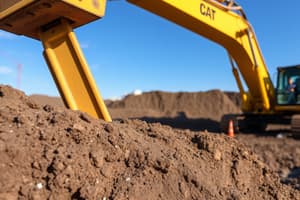Podcast
Questions and Answers
Match the excavation hazard with its description:
Match the excavation hazard with its description:
Soil Collapse = Principal Causes: Steep cutting angle, Super imposed load, Shock & Vibration, Water Pressure Falls = Hazards: Excavation Works Vehicular Traffic = Hazards: Excavation Works Confined Space Conditions = Hazards: Excavation Works
Match the type of soil with its stability level for prevention of collapse:
Match the type of soil with its stability level for prevention of collapse:
Type A = Most stable: clay Type B = Medium stability: silt and unstable rock (disturbed soil as type B) Type C = Least stable: gravel, loamy sand, submerged soil, soil from which water is freely seeping
Match the description with the type of excavation:
Match the description with the type of excavation:
Trench = A narrow excavation where the depth is greater than its width, and the width measured at the bottom is not greater than 15 ft. Excavation = Any man-made cut, cavity or depression in an earth surface that is formed by earth removal
Match the following safety measures with their corresponding categories:
Match the following safety measures with their corresponding categories:
Match the following requirements with their related details:
Match the following requirements with their related details:
Match the following actions with their corresponding safety precautions:
Match the following actions with their corresponding safety precautions:
Match the type of slope with its corresponding angle:
Match the type of slope with its corresponding angle:
Match the method of preventing soil collapse with its description:
Match the method of preventing soil collapse with its description:
Match the action required for falls with the regulation:
Match the action required for falls with the regulation:
Match the organization with its focus area:
Match the organization with its focus area:
Match the safety precaution with the Confined Space Condition it addresses:
Match the safety precaution with the Confined Space Condition it addresses:
Match the action with the Working in Excavation stage it corresponds to:
Match the action with the Working in Excavation stage it corresponds to:
Match the scenario with the Inspection frequency it requires:
Match the scenario with the Inspection frequency it requires:
Match the activity with the Groundwater Control method it involves:
Match the activity with the Groundwater Control method it involves:
Match the warning sign with the Hazardous Atmosphere condition it indicates:
Match the warning sign with the Hazardous Atmosphere condition it indicates:
Match the recommendation with the Ingress and Egress (Ladder) purpose it serves:
Match the recommendation with the Ingress and Egress (Ladder) purpose it serves:
Flashcards are hidden until you start studying
Study Notes
Excavation Safety
- Excavation is any man-made cut, cavity, or depression in an earth surface that is formed by earth removal.
- A trench is a narrow excavation where the depth is greater than its width, and the width measured at the bottom is not greater than 15 ft.
Hazards of Excavation Works
- Soil Collapse
- Falls
- Vehicular Traffic
- Underground Utilities
- Working Surface
- Confined Space Conditions
Soil Collapse
- Principal causes of soil collapse:
- Steep cutting angle
- Super imposed load
- Shock & Vibration
- Water Pressure
- Drying
- Prevention of soil collapse:
- Type A soil: most stable (clay)
- Type B soil: medium stability (silt and unstable rock)
- Type C soil: least stable (gravel, loamy sand, submerged soil)
- Cut the slope at a safe angle (H:V)
- Provision of shoring and timbering
- Use of sheet piles, plate lining system, and shielding
Prevention of Soil Collapse
- Per Rule 1413 of the Occupational Safety and Health Standards (OSHS): The walls of every excavation over 1 meter deep shall be supported by adequate shoring.
- Signs should be posted to prevent the public from going near the excavation.
Surface Crossing of Trenches
- Walkways or bridges must be provided
- Minimum clear width of 20 in
- Standard rails extended a minimum of 24 in past the surface edge
Vehicular Traffic
- Provide workers with warning vests or other suitable garments marked with reflectorized materials
- Designate a trained flagperson along with signs and barricades when necessary
- Use horn or give signals to ensure safety
Underground Utilities
- Determine location of underground facilities and take necessary steps to prevent damage to these facilities
- In an open excavation, support, protect or remove underground installation
Working Surface
- Excavation shall be kept free of water at all times
- In muddy areas, workers should be provided with boots to reduce the hazard of slipping
Prevention of Falls
- Minimum Berm - not less than one third of the depth of the excavation
- May be reduced to not less than 1 meter provided that materials are stable, shoring and barriers are present
- Barricades of at least 1 meter high should be provided
Groundwater Control
- Sump Pumping
- Well Pointing
- Single-sided Well Point
- Double-sided Well Point
Confined Space Conditions
- Hazardous Atmosphere:
- Oxygen, O2 : < 19.5% or > 23.5%
- Flammable gas concentration > 10% of Lower Flammability Limit (LFL)
- Hazardous toxic chemicals
- Check the condition of the atmosphere before entry
- Do not work alone in a confined space
- Provide lifeline, ventilation or blower, and emergency rescue equipment
Ingress and Egress (Ladder)
- Ensure safe access to and from the excavation
Working in Excavation
- Prior to opening:
- Check excavation permit
- Identify all underground installations
- Remove trees, boulders, stumps, other surface encumbrances and hazards before starting excavation
- During operations:
- Wear appropriate PPE
- Maintain safe working distance between workers
- Keep guardrails, fences, or other barricades and warning lights
- During break time:
- Do not stand or take rest on high banks of soft material
- Do not leave tools, materials, or debris in walkways, ramps, or near the edge of excavations
- Do not use guardrails as resting place
Inspection
- Daily before start of each shift
- After heavy rain
- When fissures, tension cracks, undercutting, water seepage, bulging at the bottom or other conditions occur
- When there is any indication of change or movement in adjacent structures or spoil pile
- Rule 1413 of the OSHS states that excavation shall be inspected at least once every day.
Studying That Suits You
Use AI to generate personalized quizzes and flashcards to suit your learning preferences.




